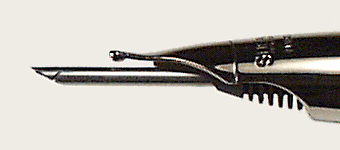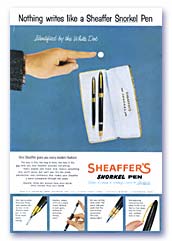| Profile: Sheaffer’s Snorkel | |||||||||||||||||||||||||||||||||||||||||||||||||||||||||||||||||||||||||||||||||||||||||||||||||||||||||||||||||||||||||||||||||||||||||||||||||||||||||||||||||||||||||||||||||||||||||||||||||||||||||||||||||||||||||||||||||||||||||||||||||||||||||||||||||||||||||||||||||||||||||||||||||||||||||||||||
| by Richard Binder | |||||||||||||||||||||||||||||||||||||||||||||||||||||||||||||||||||||||||||||||||||||||||||||||||||||||||||||||||||||||||||||||||||||||||||||||||||||||||||||||||||||||||||||||||||||||||||||||||||||||||||||||||||||||||||||||||||||||||||||||||||||||||||||||||||||||||||||||||||||||||||||||||||||||||||||||
| Article # 317 | Article Type: Pen Identification | ||||||||||||||||||||||||||||||||||||||||||||||||||||||||||||||||||||||||||||||||||||||||||||||||||||||||||||||||||||||||||||||||||||||||||||||||||||||||||||||||||||||||||||||||||||||||||||||||||||||||||||||||||||||||||||||||||||||||||||||||||||||||||||||||||||||||||||||||||||||||||||||||||||||||||||||
Snorkel Marks and Identifying Features Snorkel pens appear with two different imprints. On metal caps (and also on some plastic caps), running laterally around the cap just above the band (or above the lip on bandless caps) is the following imprint: SHEAFFER’S – MADE IN U.S.A. On plastic barrels (both metal- and plastic-capped pens), running lengthwise along the barrel at about its midpoint, is this imprint: W. A. SHEAFFER PEN CO. Palladium silver nibs, in both Triumph and open styles, appear with the following three different imprints. Nibs marked Palladium Silver have a higher silver content than nibs not so marked, which can contain as much as 95% palladium. SHEAFFER’S SHEAFFER’S SHEAFFER’S Most pens have Snorkel tubes made of stainless steel (silver or gray colored metal), but some Snorkel tubes were made of a gold-colored metal that appears to be phosphor bronze. The Snorkel tube for a Triumph nib is cut diagonally across its end and oriented so that the open surface aligns with the under surface of the feed. This alignment automatically places the slits in the tube‘s end properly. The Snorkel tube for an open nib is cut straight across its end, but it is still aligned to place its slits correctly. (The lengthwise slit at the end of the tube is nearest the nib, and the two transverse slits are therefore at the sides.) The following illustration shows a Triumph nib with its Snorkel tube extended. You can see the diagonal slits at the sides of the tube’s tip, and you can see the end of the secondary feed that runs the length of the Snorkel tube.  Two different connector rings appeared during the Snorkel's production life. The connector ring is threaded at both ends; one end screws into the gripping section, securing the point holder gasket in place, and the other screws into the nib, holding the feed in place. The end screwed into the nib is sealed with adhesive to prevent ink leaks, but the other end relies on pressure against the rubber of the point holder gasket and is not sealed. (Some modern repairers seal it on the principle that every joint should be sealed to maintain airtightness.) The earlier connector ring, apparently adapted directly from the Snorkel’s Touchdown TM predecessor, is a narrow one, of which 1/16” is exposed. The later style, which mates with a correspondingly shorter gripping section, has an exposed length of 5/32”. Some Snorkel nibs are etched with a letter and a number (for example, B4, as shown here) to indicate their size and type, according to the following tables:
Snorkel Models: Gold here, stainless steel there, a cap band over there... As illustrated here, the Snorkel appeared in a broad range of models, from the bargain-priced Special, with minimal furniture and an open palladium silver nib, to the extravagant Masterpiece, with its solid 14K gold cap and barrel and Sheaffer’s best 14K two-tone Triumph nib. Shown here, from top to bottom, are a Triumph (GF cap and barrel), a Clipper, a Valiant, and s Special. 



In 1959, Sheaffer phased out the Snorkel except for one model, the famous PFM, which was actually introduced in that year. This article offers assistance in identifying your Snorkel. Also, although Sheaffer did not date-code its pens, there is information here that will help you to narrow the span of years during which the pen might be made. Note that not all of these models were necessarily in Sheaffer’s catalog for the entire time during which Sheaffer made the Snorkel; for example, a set of catalog sheets that I have does not list the Masterpiece, Autograph, Signature, or Saratoga.
Snorkel Before the Snorkel era, Sheaffer’s pens were available in the dark and relatively sedate “primary” colors of black, Burnt Umber Brown, Burgundy, Blue, and Evergreen Green. That changed when the company introduced the Snorkel. Retaining Black, Burnt Umber Brown, and Burgundy, Sheaffer stylists discarded the dark blue and green. In response to changing popular tastes, Sheaffer replaced these colors with Aqua (also called Pastel Blue) and Pastel Green, and added Pastel Grey. Burnt Umber Brown, it should be noted, may at that time have been relegated to desk pens; I have never seen a brown pocket Snorkel. During the middle of the 1950s, while the Snorkel was still enjoying its heyday, popular tastes continued to change. Primary colors became much less fashionable as plastics technology matured and manufacturers were able to produce products in a broad variety of colors. Secondary colors, those made by mixing primaries or by subduing the color saturation, became all the rage, and Sheaffer responded once again, in 1956, by releasing a brilliant new range of colors. An interesting conundrum is why some Snorkels had self-colored sections while others had black sections. The self-colored sections appear mostly on pens made in the new colors, but some Primary-colored pens also have them. My best guess is that self-colored sections were applied, as were the new colors, to pens in the middle and lower price ranges; thus, a Valiant or an Admiral might appear in Periwinkle Blue with a self-colored section but a Crest would be restricted to the Primary colors and would always have a black section. The Primary-color restriction seems generally true for Sentinels and Clippers, but some of these pens do exist in new colors, with self-colored sections. The entries in the following table include in parentheses the factory color code designations. Note that the Primary colors are designated by letters, whereas the introduction of the new colors brought with it a new numeric designation scheme.
|
|||||||||||||||||||||||||||||||||||||||||||||||||||||||||||||||||||||||||||||||||||||||||||||||||||||||||||||||||||||||||||||||||||||||||||||||||||||||||||||||||||||||||||||||||||||||||||||||||||||||||||||||||||||||||||||||||||||||||||||||||||||||||||||||||||||||||||||||||||||||||||||||||||||||||||||||

